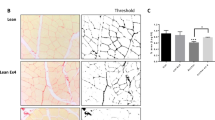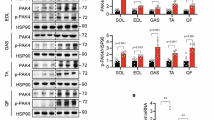Abstract
Background:
Acute infection promotes skeletal muscle wasting and insulin resistance, but the effect of insulin on energy and substrate sensing in skeletal muscle of chronically infected neonates has not been studied.
Methods:
Eighteen 2-d-old pigs underwent cecal ligation and puncture (CLP) or sham surgery (CON) to induce a chronic infection for 5 d. On d 5, pancreatic-substrate clamps were performed to attain fasting or fed insulin levels but to maintain glucose and amino acids in the fasting range. Total fractional protein synthesis rates (Ks), translational control mechanisms, and energy sensing and degradation signal activation were measured in longissimus dorsi muscle.
Results:
In fasting conditions, CLP reduced Ks and sirtuin 1 (SIRT1) and increased AMP-activated protein kinase α (AMPKα) activation and muscle RING-finger protein-1 (MuRF1). Insulin treatment increased Ks and mitochondrial protein synthesis, enhanced translation activation, and reduced SIRT1 in CON. In contrast, in CLP, insulin treatment increased Ks, protein kinase B (PKB) and Forkhead box O1 phosphorylation, antagonized AMPK activation, and decreased peroxisome proliferator-activated receptor gamma coactivator 1-α (PGC-1α), MuRF1, and SIRT1.
Conclusion:
Energy and substrate sensing in skeletal muscle by the PKB–AMPK–SIRT1–PGC-1α axis is impacted by chronic infection in neonatal pigs and can be modulated by insulin.
Similar content being viewed by others
Log in or create a free account to read this content
Gain free access to this article, as well as selected content from this journal and more on nature.com
or
References
Lang CH, Frost RA, Vary TC. Regulation of muscle protein synthesis during sepsis and inflammation. Am J Physiol Endocrinol Metab 2007;293:E453–9.
Vary TC, Siegel JH, Tall BD, Morris JG, Smith JA. Inhibition of skeletal muscle protein synthesis in septic intra-abdominal abscess. J Trauma 1988;28:981–8.
Whyte MB, Jackson NC, Shojaee-Moradie F, et al. Metabolic effects of intensive insulin therapy in critically ill patients. Am J Physiol Endocrinol Metab 2010;298:E697–705.
Ebong S, Call D, Nemzek J, Bolgos G, Newcomb D, Remick D. Immunopathologic alterations in murine models of sepsis of increasing severity. Infect Immun 1999;67:6603–10.
Orellana RA, Kimball SR, Suryawan A, et al. Insulin stimulates muscle protein synthesis in neonates during endotoxemia despite repression of translation initiation. Am J Physiol Endocrinol Metab 2007;292:E629–36.
Suryawan A, Nguyen HV, Bush JA, Davis TA. Developmental changes in the feeding-induced activation of the insulin-signaling pathway in neonatal pigs. Am J Physiol Endocrinol Metab 2001;281:E908–15.
Orellana RA, Suryawan A, Wilson FA, et al. Development aggravates the severity of skeletal muscle catabolism induced by endotoxemia in neonatal pigs. Am J Physiol Regul Integr Comp Physiol 2012;302:R682–90.
Barazzoni R, Short KR, Asmann Y, Coenen-Schimke JM, Robinson MM, Nair KS. Insulin fails to enhance mTOR phosphorylation, mitochondrial protein synthesis, and ATP production in human skeletal muscle without amino acid replacement. Am J Physiol Endocrinol Metab 2012;303:E1117–25.
Yan L, Lamb RF. Amino acid sensing and regulation of mTORC1. Semin Cell Dev Biol 2012;23:621–5.
Davis TA, Fiorotto ML, Burrin DG, et al. Stimulation of protein synthesis by both insulin and amino acids is unique to skeletal muscle in neonatal pigs. Am J Physiol Endocrinol Metab 2002;282:E880–90.
O’Connor PM, Bush JA, Suryawan A, Nguyen HV, Davis TA. Insulin and amino acids independently stimulate skeletal muscle protein synthesis in neonatal pigs. Am J Physiol Endocrinol Metab 2003;284:E110–9.
Crossland H, Constantin-Teodosiu D, Gardiner SM, Constantin D, Greenhaff PL. A potential role for Akt/FOXO signalling in both protein loss and the impairment of muscle carbohydrate oxidation during sepsis in rodent skeletal muscle. J Physiol 2008;586:5589–600.
Stitt TN, Drujan D, Clarke BA, et al. The IGF-1/PI3K/Akt pathway prevents expression of muscle atrophy-induced ubiquitin ligases by inhibiting FOXO transcription factors. Mol Cell 2004;14:395–403.
Krawiec BJ, Nystrom GJ, Frost RA, Jefferson LS, Lang CH. AMP-activated protein kinase agonists increase mRNA content of the muscle-specific ubiquitin ligases MAFbx and MuRF1 in C2C12 cells. Am J Physiol Endocrinol Metab 2007;292:E1555–67.
Cai D, Frantz JD, Tawa NE Jr, et al. IKKbeta/NF-kappaB activation causes severe muscle wasting in mice. Cell 2004;119:285–98.
Cantó C, Gerhart-Hines Z, Feige JN, et al. AMPK regulates energy expenditure by modulating NAD+ metabolism and SIRT1 activity. Nature 2009;458:1056–60.
Gerhart-Hines Z, Rodgers JT, Bare O, et al. Metabolic control of muscle mitochondrial function and fatty acid oxidation through SIRT1/PGC-1alpha. EMBO J 2007;26:1913–23.
Singleton KD, Wischmeyer PE. Distance of cecum ligated influences mortality, tumor necrosis factor-alpha and interleukin-6 expression following cecal ligation and puncture in the rat. Eur Surg Res 2003;35:486–91.
Rathmacher JA, Nissen SL. Development and application of a compartmental model of 3-methylhistidine metabolism in humans and domestic animals. Adv Exp Med Biol 1998;445:303–24.
Riché F, Gayat E, Collet C, et al. Local and systemic innate immune response to secondary human peritonitis. Crit Care 2013;17:R201.
Yilmaz TU, Kerem M, Demirtaş CY, et al. Increased resistin levels in intra-abdominal sepsis: correlation with proinflammatory cytokines and Acute Physiology and Chronic Health Evaluation (APACHE) II scores. Sultan Qaboos Univ Med J 2014;14:e506–12.
Spasojević I, Obradović B, Spasić S. Bench-to-bedside review: neonatal sepsis-redox processes in pathogenesis. Crit Care 2012;16:221.
Di Domenico A, Hofer A, Tundo F, Wenz T. Mitochondrial protein acetylation mediates nutrient sensing of mitochondrial protein synthesis and mitonuclear protein balance. IUBMB Life 2014;66:793–802.
Johnson MA, Vidoni S, Durigon R, et al. Amino acid starvation has opposite effects on mitochondrial and cytosolic protein synthesis. PLoS One 2014;9:e93597.
Peterson JM, Bakkar N, Guttridge DC. NF-κB signaling in skeletal muscle health and disease. Curr Top Dev Biol 2011;96:85–119.
Kovacic S, Soltys CL, Barr AJ, Shiojima I, Walsh K, Dyck JR. Akt activity negatively regulates phosphorylation of AMP-activated protein kinase in the heart. J Biol Chem 2003;278:39422–7.
Jäger S, Handschin C, St-Pierre J, Spiegelman BM. AMP-activated protein kinase (AMPK) action in skeletal muscle via direct phosphorylation of PGC-1alpha. Proc Natl Acad Sci USA 2007;104:12017–22.
Jørgensen SB, Wojtaszewski JF, Viollet B, et al. Effects of alpha-AMPK knockout on exercise-induced gene activation in mouse skeletal muscle. FASEB J 2005;19:1146–8.
Ljubicic V, Burt M, Lunde JA, Jasmin BJ. Resveratrol induces expression of the slow, oxidative phenotype in mdx mouse muscle together with enhanced activity of the SIRT1-PGC-1α axis. Am J Physiol Cell Physiol 2014;307:C66–82.
Rooyackers OE, Adey DB, Ades PA, Nair KS. Effect of age on in vivo rates of mitochondrial protein synthesis in human skeletal muscle. Proc Natl Acad Sci USA 1996;93:15364–9.
Livak KJ, Schmittgen TD. Analysis of relative gene expression data using real-time quantitative PCR and the 2(-Delta Delta C(T)) Method. Methods 2001;25:402–8.
Acknowledgements
We thank Jerome Stubblefield for assistance with care of animals and Rosemarie Almonaci for technical support.
Author information
Authors and Affiliations
Corresponding author
Rights and permissions
About this article
Cite this article
Manjarín, R., Suryawan, A., Koo, S. et al. Insulin modulates energy and substrate sensing and protein catabolism induced by chronic peritonitis in skeletal muscle of neonatal pigs. Pediatr Res 80, 744–752 (2016). https://doi.org/10.1038/pr.2016.129
Received:
Accepted:
Published:
Issue date:
DOI: https://doi.org/10.1038/pr.2016.129



